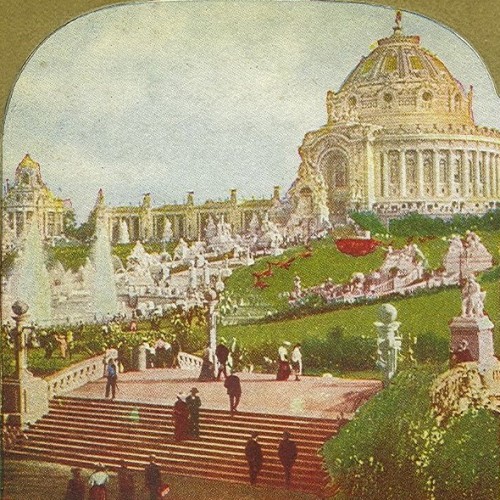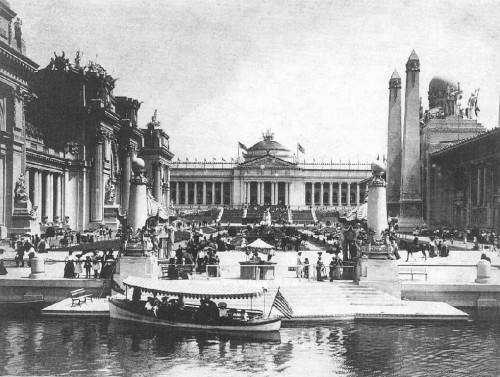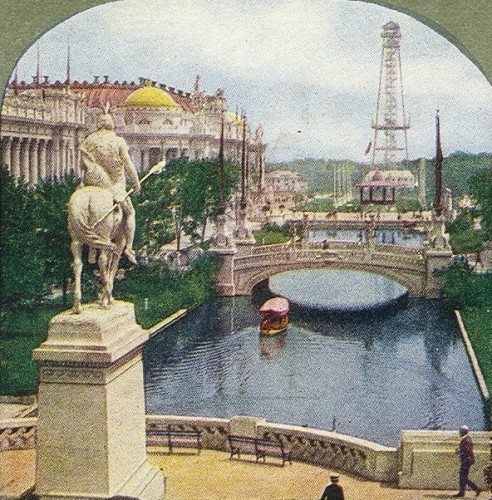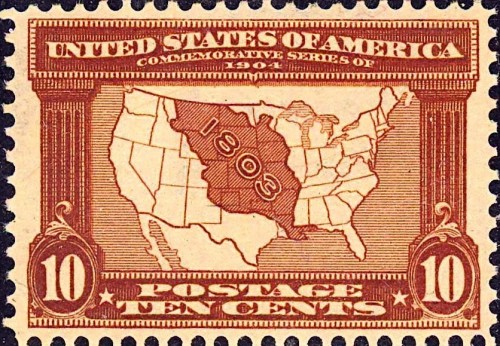Those Places Thursday: The St. Louis World’s Fair, 1904

If you did not live in St. Louis, Missouri in 1904, but had family or friends who did, your vacation would definitely be visiting them that year. Even if you didn’t have somewhere you could stay free, St. Louis was on the agenda for 19,694,855 people between 30 April 1904 and 01 December 1904.
The nation had come out of the worst recession it had ever seen to that date- the Panic of 1893 had repercussions for many years. The economy started a rapid growth spurt after William McKinley became President in 1897 and gold was found in the Klondike. The country’s pent-up demand for good times and fun played out at the fair, and Americans had the money to spend on travel and souvenirs.

The Louisiana Purchase Exposition, as it was formally known, was to celebrate the centennial of the Louisiana Purchase in 1803; opening had been delayed one year to allow more participation. It was truly an international exposition, with exhibits built by 62 foreign countries, 43 states (there were only 45 in the Union at that time), and the U. S. Government.
The fair took up 1,200 acres in prime St. Louis neighborhoods, and today those grounds are Forest Park and the Washington University campus. The ‘Flight Cage’ or Aviary (A huge bird cage in which birds fly free- very innovative for the time) is now at the St. Louis Zoo, and the Palace of Fine Art, a magnificent building, has become the St. Louis Art Museum; the statue of St. Louis on his horse is out in front.

Beautiful, expensive mansions existed alongside the 1,500+ fair buildings, with most of them constructed of “staff,” a mixture of hemp fibers and plaster of Paris, placed on a wooden frame. All but two of the buildings were only meant to last 1-2 years for the fair, but had to be continually patched throughout the seven months the fair was officially open.
With 75 miles of walkways and roads, and buildings as big as 20 acres such as the Palace of Agriculture, everything at the fair could hardly be seen in a week. A local guide, such as a family member or friend, would help visitors navigate to the very best sections of the fair.

The fair offered educational exhibits including “scientific agriculture,” art, anthropological, “curious exhibits,” great inventions and discoveries, athletics and health, “electricity up to 1904,” machinery, manufacturing, mining, and “new household methods and art.” Transportation and naval battle exhibits, and even “Women’s Progress Since the World’s Fair at Chicago” were enticing to many fair visitors. The fair even exhibited the world’s largest cedar bucket- it could hold 1,556 gallons, and was about 6 ft. tall, 6 ft. in diameter at the base and 9 ft. in diameter at the top. (You can see it today at Cannonsburgh Village in Murfreesboro, Tennessee.) Music, theater, and other entertainments filled the fair with joy for all ages. The 1904 Olympics even took place on the fairgrounds!

It has been claimed that the first waffle ice cream cone was created at the fair, and some say the hot dog, cotton candy, peanut butter, and iced tea were ‘invented’ at the fair. The fair actually made these products popular with the masses, but probably existed before 1904. Puffed Wheat cereal and the soft drink Dr. Pepper were introduced at the fair, however.
Pop culture got a boost with new music like the song, “Meet Me in St. Louis, Louis” which was sung by many artists, but the Judy Garland version in the musical “Meet Me in St. Louis” is probably best known to current generations. Scott Joplin, a St. Louis native, wrote a song about the waterfalls in front of Festival Hall, called, “Cascades” and it helped promote ragtime as the music of the day. Jazz was popular too.

Sadly, many indigenous peoples of the world were put on display, including Geronimo, the brave Apache war chief, a pygmy from the Congo, and peoples from newly-acquired territories from the Spanish-American War, such as the Philippines, Puerto Rico, and Guam. The fair did begin a conversation in America about race and ‘primitive’ peoples, and their rights. Ironically, the fair included an “educated” horse named Beautiful Jim Key, and he and his owner, a former slave who also had native-American blood, promoted humane animal treatment.

Ever heard of the St. Louis Bullfight Riot? As a native St. Louisan, I never had. But yes, a bullfight had been scheduled as a fair activity for 05 June 1904. The Missouri governor halted the fight citing the anti-bullfighting laws in Missouri. (Who knew Missouri had such laws? Holdovers from Spanish possession, perhaps? Wonder if they are still on the books today.) The spectators were angry and demanded refunds, but were turned away. So the mob rioted, burning the arena to the ground. One of the bullfighters murdered another two days later when they fought over payment for the fight that never happened with weak, emaciated bulls.

Lots of our Heritage Ramblings ancestors lived in St. Louis, many during the 1904 World’s Fair. We will tell some of those stories and see some wonderful artifacts this week.
Notes, Sources, and References:
1) Louisiana Purchase Exposition- http://en.wikipedia.org/wiki/Louisiana_Purchase_Exposition
2) University of Missouri Digital Library- scanned books, images, etc. about the 1904 St. Louis World’s Fair. http://digital.library.umsystem.edu/cgi/t/text/text-idx?c=lex;cc=lex;sid=8849264c45570e24ed20224cdef04038;rgn=full%20text;tpl=home.tpl
An excellent issue of The Cosmopolitan Magazine: http://digital.library.umsystem.edu/cgi/t/text/pageviewer-idx?c=lex;cc=lex;sid=33ae46d1ab7f86bbfd493f78bb96295b;rgn=full%20text;idno=lex012;view=image;seq=1
3) The Missouri History Museum has a wonderful collection of 1904 World’s Fair memorabilia. It is housed in the Jefferson Memorial Building (named in honor of Thomas Jefferson, President when the Louisiana Purchase occurred) near the park and is a very worthwhile visit.
4) St. Louis Bullfight- http://en.wikipedia.org/wiki/St._Louis_bullfight_riot
5) Thanks to Mary Theresa Helbling, who made “Meet Me in St. Louis” with Judy Garland a perennial late movie favorite. See “The Trolley Song” excerpt at https://www.youtube.com/watch?v=hmx1L8G25q4.
Please contact us if you would like higher resolution images. Click to enlarge images.
We would love to read your thoughts and comments about this post (see form below), and thank you for your time! All comments are moderated, however, due to the high intelligence and persistence of spammers/hackers who really should be putting their smarts to use for the public good instead of spamming our little blog.